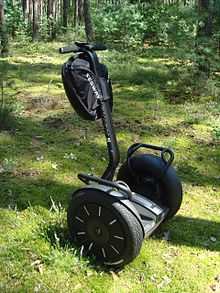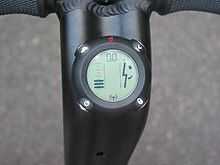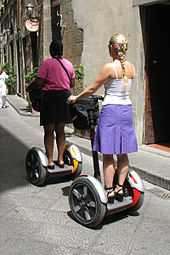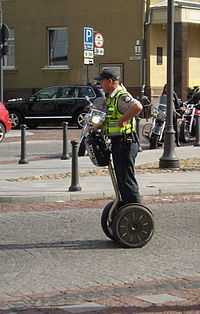Segway PT
 Segway PT | |
| Type | Electric vehicle |
|---|---|
| Wheels | Two |
| Inventor | Dean Kamen |
| Introduced | 2001 |
| Chief engineer | Doug Field |
| Dynamics engineers |
David Robinson John Morrell Jon Stevens Jon Pompa |
| Programmers |
Chuck Herscovici Gerry Rigdon Michael Kaufman Eric Pribyl Jim Dattalo |
| Electrical engineers |
Phil Lemay Mike Gansler JD Heinzmann Jason Sachs Larry Liberman Chris Kastel Zeta Electronics |
| Mechanical engineers |
Ron Reich Mike Martin Andrew Steiner Ray Debruin Patrick Kelly Jeremy Lund Mike Slate JR Holt |
| Industrial designers |
Scott Waters Tao Chang |
The Segway PT is a two-wheeled, self-balancing, battery-powered electric vehicle invented by Dean Kamen. It is produced by Segway Inc. of New Hampshire, USA. The name Segway is a homophone of the word segue, meaning smooth transition. PT is an abbreviation for personal transporter.
Computers and motors in the base of the device keep the Segway PT upright when powered on with balancing enabled. A user commands the Segway to go forward by shifting their weight forward on the platform, and backward by shifting their weight backward. The Segway detects, as it balances, the change in its center of mass, and first establishes and then maintains a corresponding speed, forward or backward. Gyroscopic sensors and fluid-based leveling sensors detect the weight shift. To turn, the user presses the handlebar to the left or the right.
Segway PTs are driven by electric motors and can reach a speed of 12.5 miles per hour (20.1 km/h).
Early history and pre-release marketing
The Segway PT was known by the names Ginger and IT before it was unveiled. Ginger came out of the first product that used Kamen's balancing technology, the iBOT wheelchair. During development at the University of Plymouth, in conjunction with BAE Systems and Sumitomo Precision Products, the iBot was nicknamed Fred Upstairs (after Fred Astaire) because it can climb stairs: hence the name Ginger, after Astaire's regular film partner, Ginger Rogers, for a successor product.
The invention, development, and financing of the Segway was the subject of a narrative nonfiction book, Code Name Ginger (in paperback as Reinventing the Wheel), by journalist Steve Kemper. The leak of information from that book led to rampant speculation about the "IT" device prior to release. The speculation created an unexpected advance buzz about the product that was, at times, hyperbolic. Steve Jobs was quoted as saying that, it was "as big a deal as the PC",[1] though later sources quoted him as saying when first introduced to the product that its design "sucked".[2] John Doerr speculated that it would be more important than the Internet.[1] Articles were written in major publications speculating on it being a Stirling engine.[3] South Park devoted an episode to making fun of the hype before the product was released.
The product was unveiled 3 December 2001, in Bryant Park, the privately managed public park located in the New York City borough of Manhattan, on the ABC News morning program Good Morning America.[4]
Technology

The dynamics of the Segway PT are similar to a classic control problem, the inverted pendulum. The Segway PT (PT is an initialism for personal transporter while the old suffix HT was an initialism for human transporter) has electric motors powered by Valence Technology phosphate-based lithium-ion batteries, which can be charged from household current. It balances with the help of dual computers that run proprietary software, two tilt sensors, and five gyroscopic sensors developed by BAE Systems' Advanced Technology Centre.[5] The servo drive motors rotate the wheels forwards or backwards as needed for balance or propulsion. The rider controls forward and backward movement by leaning the Segway relative to the combined center of mass of the rider and Segway, by holding the control bar closer to or farther from their body. The Segway detects the change in the balance point, and adjusts the speed at which it is balancing the rider accordingly. On older models, steering is controlled by a twist grip on the left handlebar, which simply varies the speeds between the two motors, rotating the Segway PT (a decrease in the speed of the left wheel would turn the Segway PT to the left). Newer models enable the use of tilting the handle bar to steer.[6]
Uses


Segways perform best in areas with adequate sidewalks, curb cuts at intersections, and ramps. They are used in some theme parks by visitors and employees. Angel Island State Park, in San Francisco Bay in California, offers Segway tours, but prohibits personal Segways except as needed by disabled visitors.[7] The special police forces trained to protect the public during the 2008 Summer Olympics used the Segway for mobility.[8]
Though a Segway-focused organization, Disability Rights Advocates for Technology,[9] advocates for Segway PT sidewalk and facility access as an ADA issue, Segways cannot be marketed in the US as medical devices: they have not been approved by the Food and Drug Administration as a medical device and Johnson & Johnson claims exclusive rights to the medical uses of the balancing technology found in the iBOT and Segway.[citation needed] Dean Kamen sold the medical rights to the technology of the iBOT, a very stable and mobile powered wheelchair, to Johnson & Johnson.[10]
A version of the Segway i2 is being marketed to the emergency medical services community. Equipped with light bars and a variety of hard and soft cases, it is sealed against wet conditions, and rated for 24 miles (39 kilometres) per charge.[11]
Use and regulation by country
Asia
- China: Police have begun using a locally made analogue of the Segway to patrol certain public areas, such as Tian'anmen square.[12]
- Israel: In 2006, the Segway was approved for use on sidewalks and other pedestrian designated locations, and on roads without sidewalks, with obstructed sidewalks or sidewalks that lack curb cuts. The user must be over 16 years old. No license is required. The maximum allowed speed is 13.5 km/h (8.4 mph), enforced by electronic restriction put in place by the importer.[13] Companies offering tours of Jerusalem use the second generation i2 model, equipped with Lean Steer Technology.[14] In 2009 the Jerusalem Biblical Zoo was the first in the world to offer Segway guided tours in the zoo.[15]
- Malaysia: On Penang island and in Malacca, Segways are available for short term hire.
- Japan: In a court, Segway was classified as a motorcycle, owing to the power output;[16] however, there is no report of registration. Segway Japan, an authorized dealer, sells Segways only to corporations to use in facilities.[17]
- Singapore: Segways were introduced to Changi Airport, initially for workers who collect baggage carts but are widely utilised by customer service and security employees. Sentosa island has a Segway rental allowing use around the island or in a small circuit.
Europe

Segways are used in Europe, but mainly in niche markets (such as guided city tours); they are not commonly used as a means of transportation. Their use on public streets is allowed in most countries, but often with restrictions. A few countries require vehicle insurance and a license plate.
- Åland islands: A law revision by the Government of Åland concerning "small electrically powered vehicles" means the Segway and all other mainly one person electrical vehicles have been classified as bicycles since 14 March 2012.
- Austria: In Vienna, Segways can be rented in the Prater amusement park. A Segway dealer in central Vienna also offers Segways for rent.
- Croatia: Use of a Segway is allowed within city limits wherever pedestrian and bicycles are allowed, i.e., sidewalks, bicycle paths, parks, etc. Segways can be rented for city tours in cities of Zagreb, Split and Dubrovnik.
- Czech Republic: Use of a Segway is allowed wherever pedestrians and bicycles are allowed. Segways can be rented for city tours, for example on the Old Town Square, Prague in the official rental Segway Point Prague, Segway Point Prague - Segway Authorized Tours.
- Denmark: the Segway is classified as a moped (knallert). As such, vehicles must be fitted with lights, license plates and mechanical brakes, the Segway is effectively banned from public roads.[18] Recently, a trial where the segway would be classified as a bicycle has been announced running from 1 June 2010 to 1 April 2011. The trial was extended to 1 December 2011, and later to the end of 2014.[19]
- Germany: Use of a Segway PT i2 is generally allowed on bicycle paths and public roads within city limits since 25 July 2009.[20] Outside city limits, the Segway may not be used on federal motorways, federal highways, state roads, and district roads. Bicycle lanes must be used if present. Riding a Segway on sidewalks and in pedestrian zones for city tours requires a special permit. The Segway is classified as an "electronic mobility aid", a new class of vehicle defined specifically for the Segway PT. Segways used on public roads must be equipped with front and rear lighting, reflectors, a bell, and an insurance plate. The driver must have procured a vehicle insurance and hold at least an M type (moped) license.
- Ireland: Segways are permitted in most public places. A Segway tour of the Phoenix Park is available. They are permitted in certain areas on bicycle paths around Dublin and Cork. The Airport Police Service stationed at Dublin Airport use the Segway i2 police patroller model. In 2011, a private tour operator started a City of Dublin Segway Tour. In October 2012 the Garda Siochana began using two examples in the Grafton Street area, funded by the Dublin Business Community.
- Italy: Use of a Segway is allowed within city limits wherever pedestrians or bicycles are allowed, i.e., sidewalks, bicycle paths, parks, etc.[21]

- Lithuania: Policemen in Vilnius, Kaunas and Palanga use segways to patrol. Also segways are available to rent for tourists in Vilnius.
- Malta: Policemen have started testing Segways on patrol in Valletta. Informed sources said the Malta Police are considering the purchase of a number of Segways fitted for police work, including a siren and space for radio and other equipment. [22]
- Netherlands: In April 2008, the Dutch Government announced that it would ease the ban it had imposed in January 2007 that made it illegal to use a Segway on public roads in the Netherlands.[23] Until recently, a tolerance policy was in place due to the inability of the authorities to classify the Segway as a vehicle.[24] However, certain handicapped people, primarily heart and lung patients, are allowed to use the Segway, but only on the pavement (US: sidewalk). From 1 July 2008, anyone over the age of 16 is permitted to use a Segway on Dutch roads but users need to buy custom insurance.[25] Amsterdam police officers are testing the Segway. In Rotterdam the Segway is used regularly by police officers and city watches.
- Norway: Because of the top speed of 20 km/h, the Segway is classified as a moped. Therefore there are requirements for registration, insurance, age limit, drivers license and helmet. To be used in Norway it must also be EU approved and classified, and the Norwegian road authorities are not aware that this has been done. Therefore, in practice, Segways cannot be used legally on public or private roads or on private property in Norway. After the election where the conservatives won, they have decided that segway will be legalised. [26] Some Segways have been sold.

- Portugal: Segways are legal on public paths from age 18 (and below, when accompanied by adults) as an equivalent to pedestrian traffic[27] and are used by many local police forces (Polícia Municipal),[28] and by Polícia Marítima (a Navy unit), for beach patrolling. They are also used (rented) by tour operators across the country, and by shopping security guards.
- Sweden: It was unlawful to use a Segway on any public road or pavement in Sweden[29] until 18 December 2008 when the Segway was re-classified as a cykel klass II (class 2 bicycle).[30] Segways are popular in Stockholm where tours are led through the streets by Segway guides with modified PTs and courses are set out at sites such as the Royal Haga park. On 1 October 2010 the Segway and similar one person electrical vehicles were re-classified as bicycles.
- Switzerland: The Segway is classified as a light motorcycle.[31] Only the PT i2 has been approved for use in Switzerland. The PT i2 may be used on roads provided that it is equipped with a Swiss Road Kit and a license plate. The Swiss Road Kit has front and back lighting, a battery source, and a license plate holder. Use on sidewalks and pedestrian zones is prohibited. An exception is made for handicapped individuals, who must obtain in advance a special authorization from the Swiss Federal Roads Office. The Segway PT i180 may also be registered for use on specific request. However, the PT i180 must be equipped with a left/right turn indicator system before it may be admitted for road use.[citation needed]
- United Kingdom: Distributed in the UK by Segway-UK, the Segway is classified as a powered vehicle and subject to Road Traffic law—with the effect that, because the Segway is deemed not to meet required safety standards, it is unlawful to use a Segway anywhere other than on private property with the owner's permission.[32] While in opposition in 2008, the Conservatives and Liberal Democrats lobbied the Labour Government to change the law to allow Segways to use public cycle lanes.[33] In July 2010, a man was charged under the Highway Act 1835 in Barnsley for riding his Segway on the pavement, and was prosecuted and fined £75 in January 2011.[34][35][36] His conviction was upheld by the High Court on appeal.[37]
North America
Canada
Restrictions on motorized vehicle use are set by provinces individually. In Alberta, Segways cannot be driven on Public Roads including sidewalks abutting public roads. Segways cannot be driven on city-owned bicycle paths in Calgary.[citation needed] Segways are allowed on private land with the landowner's permission. (Some malls allow their use.[citation needed]) In British Columbia, Segways can't legally be operated on B.C. roads or on sidewalks because they cannot be licensed or insured as a vehicle in B.C.[38] In Ontario, the Ministry of Transportation started a pilot program allowing Segways to be used by people 14 years or older with a disability, Canada Post door-to-door delivery personnel, and police officers. It was originally planned to end on October 19, 2011, but was extended by two years, and then extended again an additional five years (to October 19, 2018), due to limited participation. Prior to the end of the pilot program, the Ministry of Transportation will assess the data and information gathered from the pilot decide whether to allow Segways and how to legislate them.[39]

United States
The company has challenged bans and sought exemption from sidewalk restrictions in over 30 states. The Segway PT has been banned from use on sidewalks and in public transportation in a few municipalities, often because it is not classified as a medical device. Advocacy groups for pedestrians and the blind in the US have been critical of Segway PT use: America Walks[40] and the American Council of the Blind oppose allowing people, even those with disabilities, to drive the Segway PT on sidewalks and have actively lobbied against any such legislation.[41] Today, Segways are allowed on sidewalks in most states, though local municipalities may forbid them. Many states also allow them on bicycle lanes or on roads with speed limits of up to 25 mph.[42]
In 2011, the U.S. government Department of Justice—amending regulations that implement title II of the Americans with Disabilities Act (ADA)—ruled that the Segway is an "Other power-driven mobility devices" and its use must be permitted unless the covered entity can demonstrate that users cannot operate the class of devices in accordance with legitimate safety requirements.[43]
Segs4Vets is a nonprofit organization that provide Segway PTs to the men and women of the United States military whose service in Operations Iraqi Freedom and Enduring Freedom resulted in permanent disability and difficulty walking.[44]
- San Francisco
In November 2002, before it was widely available, the city of San Francisco banned the Segway PT from sidewalks citing safety concerns.[45] However, a number of Segway Tour operations use them in cycle lanes and designated trails.
- Washington, D.C.
In September 2010, Dr. Mary Pat McKay, a professor of emergency medicine and public health at George Washington University, issued a statement that injuries from the transporters were becoming both more common and more serious. Dr. McKay's case review in the Annals of Emergency Medicine noted 41 Segway injuries between April 2005 and November 2008 among GWU emergency room patients.[46] The District of Columbia categorizes Segways as a "personal mobility device" which means Segway users follow D.C.'s bicycle laws which do not enforce Segway users to wear helmets and other protective gear. Users are unable to wear headphones with the exception of hearing aids or other devices that only require the use of one ear.[47][48] Similar accidents have continued to occur in the District of Columbia, including a June 2012 incident involving a Dallas, Texas high school student who lost control of his Segway after fainting during a commercially operated Segway tour. Pursuant to the District's Code, Segways are prohibited on sidewalks within the Central Business District—bounded by 23rd Street NW to the west, Massachusetts Avenue to the north, Second Street NE to the east, and D Street to the south—unless operated by a person with a disability.[49]
- Disney
In February 2004, Disney banned Segway PTs from its theme parks, stating they had not been approved by the FDA as medical devices.[50] In the same month,[51] Disney began offering Segway tours of its Epcot theme park.[52] In early August 2007, Disney began offering a similar guided tour in its Disney California Adventure Park park in California.[53]
Mexico
In Mexico there is no regulation that limits Segway use in public spaces.[54]
Dominican Republic
The devices are used on group ecotours in the area south of Punta Cana.
Oceania
In Australia laws are determined at the state & territory level, each differing in their adoption of the Australian Road Rules. It is generally illegal to use the two-wheeled electric transporters in public places and on roads throughout Australia.
In the Australian Capital Territory, use of Segways is illegal on roads and other public places, but, as of June 2012, was permitted around Canberra’s Lake Burley Griffin and other tourist attractions, subject to training, safety equipment and speed limit requirements.[55][56]
In New South Wales, the Segway has been confirmed by the Roads and Traffic Authority as being illegal on both roads and footpaths. "In simple terms, riders are way too exposed to mix with general traffic on a road and too fast, heavy and consequently dangerous to other users on footpaths or cycle paths."[57] Although this does not render them totally illegal (they may still, for example, be used on private property), their uses are limited enough that they are not sold to the general public.
In Queensland, the use of the Segway became legal on the 1st of August 2013. Queensland transport Minister Scott Emerson noted that it makes sense for Segways to be allowed on public paths across Queensland, given users wear helmets.
In Western Australia, the law enables Electric Personal Transporters (EPT) (Segways) to be used as part of a supervised commercial tour, being run by an operator that holds the appropriate approvals. You may use an EPT on private property. Tour operators should approach the Local Authority where they wish to operate the tour. Local authorities have ultimate responsibility for approving tour operators within their respective areas.[58][59]
In New Zealand the Segway PT is classed as a mobility device, in the same category as a mobility segway scooter or electric wheelchair. Mobility Devices must be ridden on footpaths where possible, at a speed that does not endanger others, and give way to pedestrians.[60] This ruling might not be consistently applied: in 2011, police in Taupo in New Zealand's North Island had to stop using Segways because there is no separate vehicle classification that applies to them, requiring their registration as roadworthy in the same manner as cars.[61]
See also
- Bay Area SEG, The Bay Area Segway Enthusiasts Group that founded Segway polo
- Honda U3-X, a self-balancing one-wheeled electric vehicle by Honda
- HUBOWAY, a self-balancing two-wheeled scooter by KAIST
- Segs4Vets, provides Segways to United States wounded Veterans
- Segway Fest, an annual convention of Segway PT users and enthusiasts
- Segway polo, similar to polo, except that instead of playing on horseback, each player rides a Segway PT on the field
- Toyota Winglet, a self-balancing two-wheeled scooter by Toyota
- Trikke Pon-e, a three-wheeled hybrid personal transporter.
References
- ↑ 1.0 1.1 "Reinventing the Wheel - TIME". TIME. 2 December 2001. Retrieved 11 March 2009.
- ↑ "Steve Jobs and Jeff Bezos meet "Ginger"," Steve Kemper, Harvard Business School Working Knowledge, 16 June 2003
- ↑ Michelle Delio (9 March 1945). "'Ginger': Kamen's Stirling Idea". Wired.com. Retrieved 11 March 2009.
- ↑ Machrone, Bill (3 December 2001). "Ginger Unveiled-It's a Scooter!". Extremetech.com. Retrieved 11 March 2009.
- ↑
- ↑ "Segway, Official Site". Segway.com. 28 April 2011. Retrieved 6 November 2011.
- ↑ "Angel Island SP". Retrieved 2 August 2008.
- ↑ "Wheel scary: Chinese anti-terror police practise killing drills on scooters | Mail Online". Mailonsunday.co.uk. 2 July 2008. Retrieved 11 March 2009.
- ↑ "Disability Rights Advocates for Technology". Retrieved 6 August 2008.
- ↑ Higginbotham, Adam (27 October 2008). "Dean Kamen: part man, part machine". The Daily Telegraph (London). Retrieved 26 September 2009.
- ↑ "EMS LifeLine". StreetSmart Segway. Retrieved 6 November 2011.
- ↑ China's military tries out Segways http://news.cnet.com/8301-17912_3-9983589-72.html
- ↑ "Transportation regulations". rsa.gov.il. Retrieved 4 July 2011.
- ↑ "Jerusalem Segway Tours". zu-zu.co.il. Retrieved 31 May 2012.
- ↑ "Jerusalem Zoo Segway Tours". zu-zu.co.il. Retrieved 31 May 2012.
- ↑ 石田真一. "『セグウェイ』は整備不良...50万円の罰金命令". Response.jp. Retrieved 11 March 2009. (Japanese)
- ↑ Will Segway sci-fi ever be everyday fact? | The Japan Times Online 15 November 2009
- ↑ "Færdselsstyrelse: En Segway er en knallert" (in Danish). Danmarks Radio. 24 August 2007. Retrieved 23 October 2007.
- ↑ "Forlængelse af forsøg med elektrisk drevne en-akslede køretøjer". Færdselstyrelsen. 23 December 2011. Retrieved 2 May 2012.
- ↑ "Bundesgesetzblatt: Verordnung über die Teilnahme elektronischer Mobilitätshilfen am Verkehr" (in German). 24 June 2009. Retrieved 29 April 2010.
- ↑ "Normativa Vigente" (in Italian).
- ↑ "Valletta Police on the beat, using Segways". Times Of Malta. 11 August 2011.
- ↑ Stevenson, Reed (18 April 2008). "Dutch to ease ban on self-balancing Segway scooter | Technology". Reuters. Retrieved 11 March 2009.
- ↑ "RTL Nieuws.nl - Segway voor gehandicapten toegestaan". Rtl.nl. Retrieved 11 March 2009.
- ↑
- ↑ "Politiet - Segway ulovlig i Norge" (in Norwegian). Politiet. 8 June 2005. Retrieved 22 September 2013.
- ↑ "'Segways' são legais e voltam às ruas de Lisboa [Portugal]" (in Portuguese).
- ↑ "Polícia Municipal de Coimbra acquire Segway PT i2 - Segway" (in Portuguese).
- ↑ "Segway | Support | Lagar & regler". Segway.se. Retrieved 11 March 2009.
- ↑ "Segway klassad som cykel" (in (Swedish)). DN.se. 18 December 2008. Retrieved 11 March 2009.
- ↑ "Le Segway PT i2 est homologué en Suisse!" (PDF) (in French). Segway. 20 May 2009. Retrieved 20 May 2009.
- ↑ "Department for Transport - Regulations for Self-balancing Scooters". Dft.gov.uk. Archived from the original on 12 May 2008. Retrieved 11 March 2009.
- ↑ "Politics | MPs want Segways allowed on roads". BBC News. 22 April 2008. Retrieved 11 March 2009.
- ↑ "Judgement in R v Phillip Coates at Barnsley Magistrates' Court". Judiciary.gov.uk. 18 January 2011. Retrieved 20 January 2011.
- ↑ "Barnsley Segway scooter commuter in 'legal first'". BBC News. 16 July 2010. Retrieved 3 August 2010.
- ↑ "Segway Motor Scooter Commuter Loses Legal Challenge". BBC News. 18 January 2011.
- ↑ "Coates v Crown Prosecution Service (2011) EWHC 2032 (Admin)". British and Irish Legal Information Institute. 29 July 2011. Retrieved 1 August 2011.
- ↑ "BC Segway Scooters Legal Vehicle". cbc.ca. 13 July 2009.
- ↑ "Frequently Asked Questions - Segway™ (Human Transporter / Personal Transporter) Pilot Test". 13 July 2009.
- ↑ Schwartz, John (23 January 2003). "On the Pavement, a New Contender". New York Times. Retrieved 20 March 2009.
- ↑ "The American Council of the Blind's official position". "The Segway may well have a good use and place in our environment, but it is clear [...] that insufficient attention is being paid to pedestrian safety and injuries and deaths are not the price we should be paying for innovation"
- ↑ "Segway Laws". Ghsa.org. Retrieved 11 March 2009.
- ↑ "FACT SHEET: Highlights of the Final Rule to Amend the Department of Justice's Regulation Implementing Title II of the ADA". United States Department of Justice. Retrieved October 26, 2012.
- ↑ Thornton, Patrick (May 15, 2008). "Wounded Vets Increase Mobility with Segways". Military.com.
- ↑ "San Francisco - News - Showing Segway the Highway". Sfweekly.com. 18 December 2002. Retrieved 11 March 2009.
- ↑ "MSNBC - News - Segway scooters can lead to serious injuries, experts warn". MSNBC.com. 29 September 2010. Retrieved 18 June 2012.
- ↑ ((cite web|url=http://www.washingtoncitypaper.com/blogs/citydesk/2013/04/26/the-answers-column-how-are-segways-regulated-in-d-c/|title=Washington City Paper - News - How are segways regulated in D.C.? |publisher=washingtoncitypaper.com |date=26 April 2013 |accessdate=17 October 2013}
- ↑ http://www.dc.gov/DC/DDOT/On+Your+Street/Bicycles+and+Pedestrians/View+All/ci.Bicycle+Laws.print
- ↑ "TheExaminer - News - Segways now sidewalk legal for D.C. disabled". WashingtonExaminer.com. 23 September 2009. Retrieved 18 June 2012.
- ↑ 2:54 pm ET (9 February 2004). "Anger at Disney over Segway ban - Games - MSNBC.com". MSNBC. Retrieved 11 March 2009.
- ↑ "Walt Disney World Park Update (Walt Disney World Park Update) by Mark Goldhaber". Mouseplanet.com. 16 February 2004. Retrieved 11 March 2009.
- ↑ "Around the World at Epcot". Disneyworld.disney.go.com. Retrieved 11 March 2009.
- ↑ "Disneyland® - Upgrade Your Browser". Disneyland.disney.go.com. Retrieved 11 March 2009.
- ↑ "FAQ". Segway Mexico.
- ↑ "Canberra Segway ban lifted". June 12, 2012.
- ↑ "A Review of Segway Use and Commercialisation in the Australian Capital Territory" (Feb 2012). Retrieved 13 December 2012.
- ↑ "Segway test: ride a mock horse". Sydney Morning Herald. 3 January 2008. Retrieved 11 March 2009.
- ↑ "Changes to allow limited use of segways". Minister for Transport, Western Australia. 14 April 2013.
- ↑ "Electric Personal Transporters (EPT) (Segways)". Department of Transport, Western Australia. 18 April 2013.
- ↑ Segway NZ "Segway - Support - Regulatory Information". Retrieved 28 October 2010
- ↑ AFP (20 January 2011). "Police Segways fall foul of NZ law". ABC News. Retrieved 13 February 2011.
External links
| Wikimedia Commons has media related to Segways. |
- Official website
- Segway Glides as Gasoline Jumps at Wall Street Journal
- A Tribute to the Segway - slideshow by Life magazine
| ||||||||